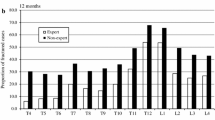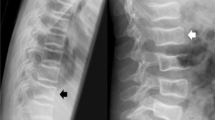Abstract
Radiographically detected vertebral fractures (VF) are a hallmark of osteoporosis. Several approaches to describe VF have been proposed. The objective of this study was to evaluate the intra- and interobserver variability of semiquantitative Kleerekoper’s method in osteoporotic VF assessment. Sixty-seven postmenopausal osteoporotic (L2–4 T-score ≤−2.5) women with a mean age of 65.2±7.51 years were included into the study. Lateral radiographs of thoracic and lumbar spine were evaluated in all patients. Kleerekoper’s method was used to define VF. Two observers evaluated all radiographs independently. To investigate intraobserver reproducibility, the first observer reevaluated all radiographs a month later on a separate occasion. Intra- and interobserver agreement was calculated using the kappa statistic. The agreement between two readings for the first observer was 86.3% with a corresponding kappa score of 0.573 (95% confidence limits of kappa score were 0.505–0.642). Interobserver agreement was 87.7% with a corresponding kappa score of 0.660 (95% confidence limits were 0.602–0.718). We observed a moderate agreement for Kleerekoper’s method in vertebral fracture assessment. There is no gold standard or standardized measurement or description for VF. Quantitative assessment of VF is essential in epidemiologic studies and in clinical drug trials, but a semiquantitative technique, which is done by experienced observers, should also be added to evaluate the entire spectrum of visible features that are helpful in identifying deformities.

Similar content being viewed by others
References
Cooper C, Atkinson EJ, O’ Fallon WM, Melton LJ III (1992) Incidence of clinically diagnosed vertebral fractures: a population- based study in Rochester, Minnesota, 1985–1989. J Bone Miner Res 7:221–227
Genant HK, Jergas M (2003) Assessment of prevalent and incident vertebral fractures in osteoporosis research. Osteoporos Int 14 [Suppl 3]:S43–S55
Jensen KK, Tougaard L (1981) A simple X-ray method for monitoring progress of osteoporosis. Lancet 2:19–20
Genant HK, Wu CY, van Kuijk C, Nevitt MC (1993) Vertebral fracture assessment using a semiquantitative technique. J Bone Miner Res 8:1137–1148
Wu CY, Li J, Jergas M, Genant HK (1995) Comparison of semiquantitative and quantitative techniques for the assessment of prevalent and incident vertebral fractures. Osteoporos Int 5:354–370
Grados F, Roux C, de Vernejoul MC, Utard G, Sebert JL, Fardellone P (2001) Comparison of four morphometric definitions and a semiquantitative consensus reading for assessing prevalent vertebral fractures. Osteoporos Int 12:716–722
Kleerekoper M, Parfitt AM, Ellis BI (1984) Measurement of vertebral fracture rates in osteoporosis. In: Christiansen C, Arnaud CD, Nordin BEC, Parfitt AM, Peck WA, Riggs BL (eds) Copenhagen International Symposium on Osteoporosis 1984, vol 1. Department of Clinical Chemistry, Glostrup Hospital, Copenhagen, pp 103–109
Svanholm H, Starklint H, Gundersen HJ, Fabricius J, Barlebo H, Olsen S (1989) Reproducibility of histomorphologic diagnosis with special reference to the kappa statistic. APMIS 97:689–698
Hedlund LR, Gallagher JC (1988) Vertebral morphometry in diagnosis of spinal fractures. Bone Miner 5:59–67
Jensen GF, McNair P, Boesen J, Hegedus V (1984) Validity in diagnosing osteoporosis. Observer variation in interpreting spinal radiographs. Eur J Radiol 4:1–3
Li J, Wu CY, Jergas M, Genant HK (1995) Diagnosing prevalent vertebral fractures: a comparison between quantitative morphometry and a standardized visual (semiquantitative) approach. In: Genant HK, Jergas M, van Kuijk C (eds) Vertebral fracture in osteoporosis. Radiology Research and Education Foundation, San Francisco, pp 271–280
Lems WF, Jahangier ZN, Raymakers JA, Jacobs JWG, Bijlsma JWJ (1997) Methods to score vertebral deformities in patients with rheumatoid arthritis. Br J Rheumatol 36:220–224
Melton LJ III, Kan SH, Frye MA, Wahner HW, O’Fallon WM, Riggs BL (1989) Epidemiology of vertebral fractures in women. Am J Epidemiol 129:1000–1011
Minne HW, Leidig G, Wuster C, Siromachkostov L, Baldauf G, Bickel R et al (1988) A newly developed spine deformity index (SDI) to quantitate vertebral crush fractures in patients with osteoporosis. Bone Miner 3:335–349
Raymakers JA, Kapelle JW, van Beresteijn ECH, Duursma SA (1990). Assessment of osteoporotic spine deformity. A new method. Skeletal Radiol 19:91–97
Black DM, Cummings SR, Stone K, Hudes E, Palermo L, Steiger P (1991) A new approach to defining normal vertebral dimensions. J Bone Miner Res 6:883–892
Kleerekoper M, Nelson DA (1992) Vertebral fracture or vertebral deformity. Calcif Tissue Int 50:5–6
Spector TD, McCloskey EV, Doyle DV, Kanis JA (1993) Prevalence of vertebral fracture in women and the relationship with bone density and symptoms: the Chingford Study. J Bone Miner Res 8:817–822
Black DM, Palermo L, Nevitt MC, Genant HK, Epstein R, San Valentin R, Cummings SR (1995) Comparison of methods for defining prevalent vertebral deformities: the study of osteoporotic fractures. J Bone Miner Res 10:890–902
Smith-Bindman R, Cummings SR, Steiger P, Genant HK (1991) A comparison of morphometric definitions of vertebral fracture. J Bone Miner Res 6:25–34
Sauer P, Leidig G, Minne HW, Duckeck G, Schwarz W, Siromachkostov L et al (1991) Spine deformity index (SDI) versus other objective procedures of vertebral fracture identification in patients with osteoporosis: a comparative study. J Bone Miner Res 6:227–238
Adami S, Gatti D, Rossini M, Adamoli A, James G, Girardello S et al (1992) The radiological assessment of vertebral osteoporosis. Bone 13 [Suppl 2]:S33–S36
McCloskey EV, Spector TD, Khan S, Sirtori P, Nagatsuka K, Kanis JA (1993) Prevalence of vertebral deformity and concordance between definitions of fracture. In: Christiansen C, Riis B (eds) Fourth International Symposium on Osteoporosis and Consensus Development Conference. ApS Osteopress, Hong Kong, pp 62–64
Author information
Authors and Affiliations
Corresponding author
Rights and permissions
About this article
Cite this article
Olmez, N., Kaya, T., Gunaydin, R. et al. Intra- and interobserver variability of Kleerekoper’s method in vertebral fracture assessment. Clin Rheumatol 24, 215–218 (2005). https://doi.org/10.1007/s10067-004-1008-2
Received:
Accepted:
Published:
Issue Date:
DOI: https://doi.org/10.1007/s10067-004-1008-2




